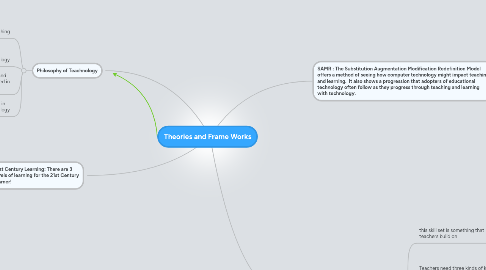
1. Philosophy of Teachnology
1.1. Similar to a philosophy of teaching
1.2. teachers can develop written statements which outline their Philosophy of Teachnology
1.3. addresses a teacher's personal values and ideas about how technology can be used in their teaching
1.4. my PLN could be included in my philosophy of Teachnology
2. 21st Century Learning: There are 3 levels of learning for the 21st Century learner!
2.1. #1.Foundational Knowledge: The learner would need foundational knoweldge in 3 areas
2.1.1. 1. Core Content
2.1.2. 2. Digital and Information Literacy
2.1.3. 3. Cross Disciplinary
2.2. #2.Meta Knowledge: The learner would have three categories of Meta Knowledge.
2.2.1. 1. Problem Solving and Critical thinking
2.2.2. 2. Communication and Collaboration
2.2.3. 3. Creativity
2.3. #3. Humanistic Knowledge: There are 3 areas
2.3.1. 1. Life and Job skills
2.3.2. Cultural Competence
2.3.3. Eithical and Emotional Awareness
3. SAMR : The Substitution Augmentation Modification Redefinition Model offers a method of seeing how computer technology might impact teaching and learning. It also shows a progression that adopters of educational technology often follow as they progress through teaching and learning with technology.
3.1. Substitution:Computer technology is used to perform the same task as was done before the use of computers
3.2. Augmentation:Computer Technology offers an effective tool to perform common tasks.
3.3. Modification:This is the first step over the line between enhancing the traditional goings-on of the classroom and transforming the classroom. Common classroom tasks are being accomplished through the use of computer technology.
3.4. Redefintion:Computer technology allows for new tasks that were previously.
3.5. Teaching and Learning through technology
3.5.1. Authenticity
3.5.1.1. Student has real world reason to learn concepts
3.5.1.2. High stakes performance based assessments
3.5.2. Student as learner
3.5.2.1. student shows knowledge through varied assessments
3.5.2.2. Differentiate through individual contracts
3.5.2.3. Concepts/content received through multiple technologies
3.5.3. Writing skills
3.5.3.1. Google site/ form for critical friend
3.5.3.2. Google comments for peer feedback
3.5.3.3. Write for authentic audience
3.5.4. Stimulations
3.5.4.1. Web-based
3.5.4.2. Concord Consortium
3.5.4.3. Animations
3.5.5. Student voice
3.5.5.1. Google group
3.5.5.1.1. Study group
3.5.5.1.2. Book reviews
3.5.5.1.3. Discussion
4. TPACK is where these types of knowledge intersect so that teachers know the right kind of technology will best convey content in a pedagogically sound mannner
4.1. this skill set is something that teachers build on
4.2. Teachers need three kinds of knowledge
4.2.1. Technology
4.2.2. Content
4.2.3. Pedology
4.3. TPACK also emphasizes the new kinds of knowledge that lie at the intersections between them, representing four more knowledge bases teachers applicable to teaching with technology
4.3.1. Pedagogical Content Knowledge
4.3.2. Technological Content Knowledge
4.3.3. Technological Pedagogical Knowledge
4.3.4. the intersection of all three circles, Technological Pedagogical Content Knowledge : TPACK!
